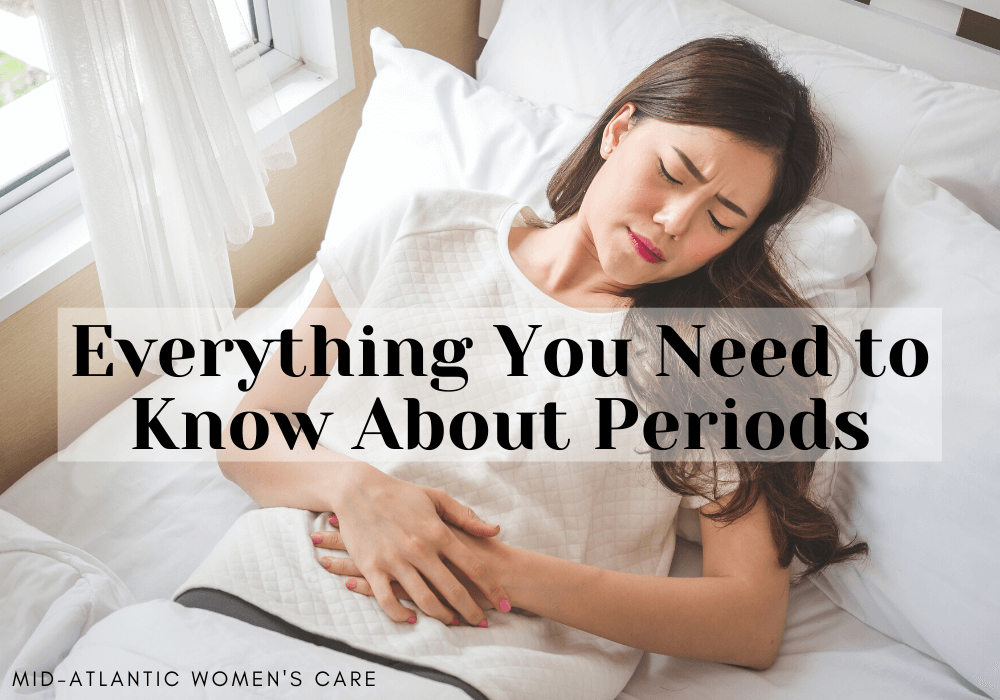Everything You Need to Know About Periods

A period, also known as menstruation or a menstrual cycle, occurs when the lining of a female’s uterus breaks down and leaves the body, usually every month. The lining is made up of blood, tissue, and nutrients – the development of which is the body’s preparation for pregnancy. If pregnancy does not occur, meaning the woman’s egg is not fertilized by a sperm, hormones tell the body to shed the lining that’s been built over the last 28 days (on average), resulting in a period that varies in length from one woman to the next.
When do periods begin and end?
Periods start during puberty, which is when a girl’s body begins to change, typically between the ages of 8 and 15 years old. It’s important to remember that periods look different for everyone so the side effects, ages at which it starts and ends, and how long each menstrual cycle lasts vary from person to person. However, as a rule of thumb, if a girl’s period has not started by the age of 16, she should be evaluated by a physician to assess the cause of the delay.
Periods end when women enter menopause which generally falls between the ages of 45 and 55 years old.
What side effects come along with a period?
Side effects may start up to two weeks before the start of a menstrual cycle. Women may notice a change in the body with symptoms called Premenstrual Syndrome (PMS). These can include:
- Back pain
- Fatigue
- Acne and breakouts
- Headaches
- Abdominal cramps
- Bloating
- Mood swings
- Insomnia
- Swollen or tender breasts
As these symptoms recur each month around the same time, they usually start to become predictable and more manageable. When symptoms start to become overwhelming, there are steps you can take to ease them:
- Limit intake of fat, salt, sugar, caffeine, and alcohol. An adjustment in diet can help to ease the side effects of PMS.
- Exercise regularly.
- Over the counter medications like acetaminophen and ibuprofen can effectively lessen symptoms.
- Consider hormonal birth control like the pill.
If you find that any of these premenstrual symptoms are overwhelming to the point that they are impacting your daily life, you should talk to your OBGYN. He or she may be able to find ways to ease the intensity and frequency of your symptoms.
Should I use pads, tampons, or a menstrual cup?
There is no right or wrong answer here because all three methods allow women to go about their daily lives by collecting the blood that the body releases during a period. It is, however, important to know the basics of each option to make the best decision for you.
Pads are worn outside of the body so they collect the blood after it exits the body. Most pads are disposable after one use while others are made of cloth and meant to be washed after use. The material is highly absorbent to avoid leakage. Many women start off using pads when they first start their periods because they don’t require insertion into the vagina and are easy to use.
Tampons act almost like a plug that’s inserted into the vagina where it absorbs the menstrual blood before it leaves the body. Tampons generally come with an applicator that makes for easy and quick insertion and have a string that makes for easy removal. They are also highly absorbent and disposable after one use (up to 8 hours). Many women prefer tampons because they are small and discreet, they are usually not felt once they’ve been properly inserted into the body, and they allow women to engage in a greater range of activities than pads do, including swimming and other active sports. It is very important to change tampons every 4-8 hours (overnight is also ok) to avoid bacteria buildup which can result in a very rare condition called Toxic Shock Syndrome (TSS). This rare but serious condition can result from wearing a tampon for longer than 8 hours.
Menstrual cups look like little inverted bells and similarly to tampons, they are worn inside the vagina. Rather than absorbing the blood like both pads and tampons, menstrual cups are made of medical-grade flexible silicone and collect the blood while inside the vagina. They are then emptied, washed, and reinserted into the vagina. Menstrual cups are more environmentally-friendly as they are not thrown out after a single use, which is why many women prefer this method. Women also like menstrual cups because they can be worn for up to 12 hours at a time without the risk of developing Toxic Shock Syndrome.
Can you get pregnant on your period?
You sure can! Although the risk of pregnancy is lower during your period, it is still a good idea to use some form of birth control to avoid unintentional pregnancies.
What to do if your period comes late
First, do not panic! It is common for periods to not always come 28 days apart on the dot. A typical menstrual cycle falls between 21-34 days, but there are quite a few factors that can affect the regularity of periods including weight gain or loss, stress, diet, medication, excessive exercise, and other lifestyle factors.
If your period does not come within 35 days and you are sexually active, you should take a pregnancy test even if you are on birth control. If a pregnancy test comes back negative or you are not sexually active, you should check in with your doctor who may want to conduct tests to determine the cause of this irregularity.
If you have additional questions, our highly knowledgeable staff has answers. Call us to set up an appointment: 757-455-8833.